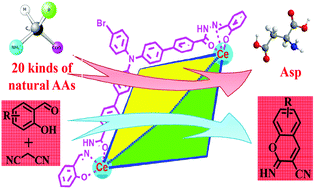Amide-containing luminescent metal–organic complexes as bifunctional materials for selective sensing of amino acids and reaction prompting†
Abstract
Two new cerium-based luminescent metal–organic complexes (MOCs), Ce–BBAS and Ce–TBAS, were achieved via self-assembly of two and three additional free amide-functionalized ligands and cerium(III) nitrate, respectively. These two MOCs exhibit different opening size and inner cavities. The smaller metal–organic triple-stranded helicate Ce–BBAS exhibits high selectivity toward aspartic acid (Asp) over other natural amino acids, with the detection limit of ca. 0.26 μM, providing the first artificial receptor that can specifically discriminate Asp over other amino acids in a luminescence enhancement manner. As a comparison, the bigger metal–organic tetrahedron Ce–TBAS doesn't reflect this nature, demonstrating size-selective sensing. In addition, these two MOCs could also work as luminescent chemosensors towards salicylaldehyde derivatives, and feature confined cavities and amide groups as a base catalytic driving force to enable the Knoevenagel condensation reactions.


 Please wait while we load your content...
Please wait while we load your content...